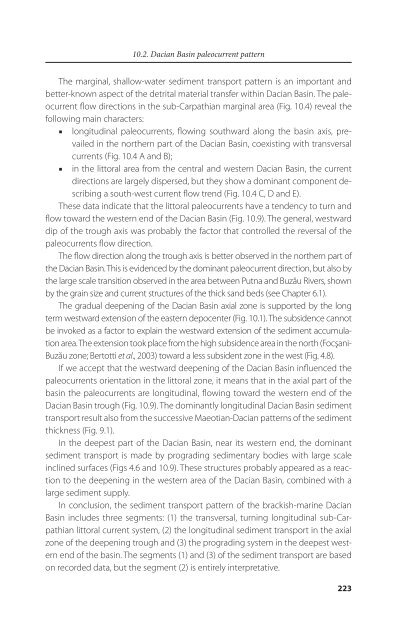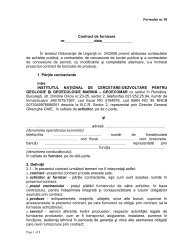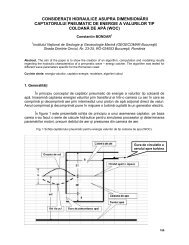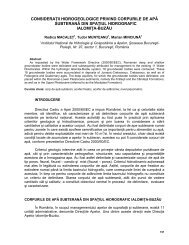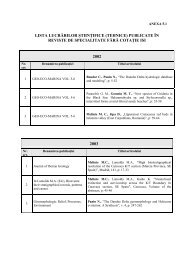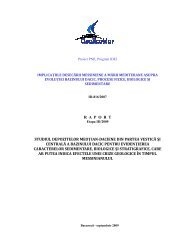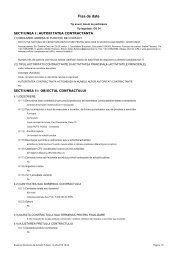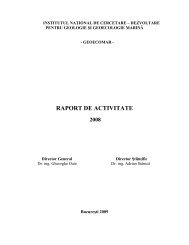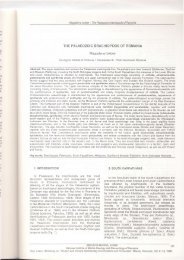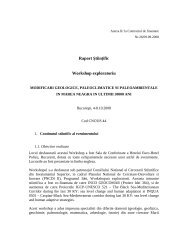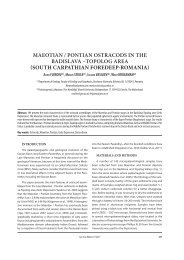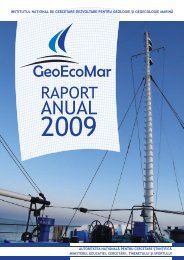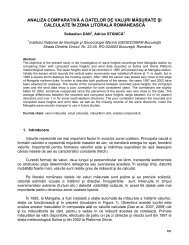DACIAN BASIN - GeoEcoMar
DACIAN BASIN - GeoEcoMar
DACIAN BASIN - GeoEcoMar
Create successful ePaper yourself
Turn your PDF publications into a flip-book with our unique Google optimized e-Paper software.
10.2. Dacian Basin paleocurrent pattern<br />
The marginal, shallow-water sediment transport pattern is an important and<br />
better-known aspect of the detrital material transfer within Dacian Basin. The paleocurrent<br />
flow directions in the sub-Carpathian marginal area (Fig. 10.4) reveal the<br />
following main characters:<br />
■ longitudinal paleocurrents, flowing southward along the basin axis, prevailed<br />
in the northern part of the Dacian Basin, coexisting with transversal<br />
currents (Fig. 10.4 A and B);<br />
■ in the littoral area from the central and western Dacian Basin, the current<br />
directions are largely dispersed, but they show a dominant component describing<br />
a south-west current flow trend (Fig. 10.4 C, D and E).<br />
These data indicate that the littoral paleocurrents have a tendency to turn and<br />
flow toward the western end of the Dacian Basin (Fig. 10.9). The general, westward<br />
dip of the trough axis was probably the factor that controlled the reversal of the<br />
paleocurrents flow direction.<br />
The flow direction along the trough axis is better observed in the northern part of<br />
the Dacian Basin. This is evidenced by the dominant paleocurrent direction, but also by<br />
the large scale transition observed in the area between Putna and Buzău Rivers, shown<br />
by the grain size and current structures of the thick sand beds (see Chapter 6.1).<br />
The gradual deepening of the Dacian Basin axial zone is supported by the long<br />
term westward extension of the eastern depocenter (Fig. 10.1). The subsidence cannot<br />
be invoked as a factor to explain the westward extension of the sediment accumulation<br />
area. The extension took place from the high subsidence area in the north (Focşani-<br />
Buzău zone; Bertotti et al., 2003) toward a less subsident zone in the west (Fig. 4.8).<br />
If we accept that the westward deepening of the Dacian Basin influenced the<br />
paleocurrents orientation in the littoral zone, it means that in the axial part of the<br />
basin the paleocurrents are longitudinal, flowing toward the western end of the<br />
Dacian Basin trough (Fig. 10.9). The dominantly longitudinal Dacian Basin sediment<br />
transport result also from the successive Maeotian-Dacian patterns of the sediment<br />
thickness (Fig. 9.1).<br />
In the deepest part of the Dacian Basin, near its western end, the dominant<br />
sediment transport is made by prograding sedimentary bodies with large scale<br />
inclined surfaces (Figs 4.6 and 10.9). These structures probably appeared as a reaction<br />
to the deepening in the western area of the Dacian Basin, combined with a<br />
large sediment supply.<br />
In conclusion, the sediment transport pattern of the brackish-marine Dacian<br />
Basin includes three segments: (1) the transversal, turning longitudinal sub-Carpathian<br />
littoral current system, (2) the longitudinal sediment transport in the axial<br />
zone of the deepening trough and (3) the prograding system in the deepest western<br />
end of the basin. The segments (1) and (3) of the sediment transport are based<br />
on recorded data, but the segment (2) is entirely interpretative.<br />
223


